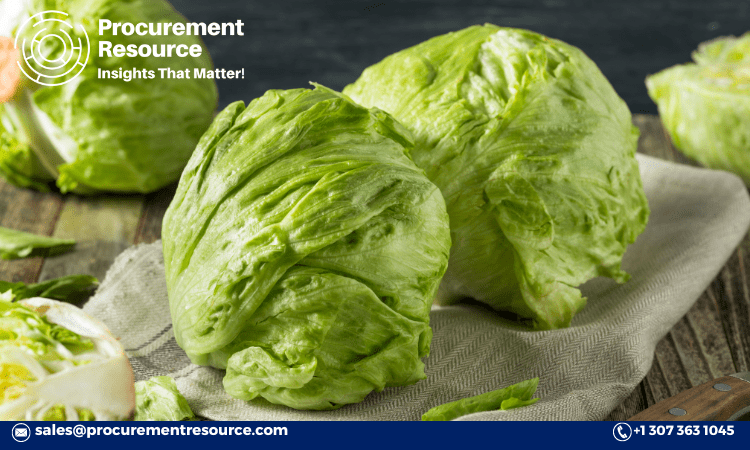Lettuce is one of the most widely cultivated leafy vegetables globally, essential for salads and various culinary dishes. Its demand is driven by increasing health awareness and the growing trend towards healthy eating habits. The cost of lettuce production is influenced by various factors, including location, agricultural practices, labour costs, and climate conditions. This blog post provides a comprehensive overview of the factors that contribute to lettuce production costs and the key insights that affect its profitability.
Lettuce Production Overview
Lettuce is predominantly grown in temperate regions, requiring well-drained soils and moderate temperatures for optimal growth. The cultivation process involves several stages, from land preparation, seed selection, irrigation, pest control, and harvesting. Understanding the intricacies of lettuce farming is essential for calculating production costs and ensuring efficiency across the supply chain.
Request For Sample: https://www.procurementresource.com/production-cost-report-store/lettuce/request-sample
Breakdown of Lettuce Production Costs
- Land Preparation Costs
- Soil Preparation: Lettuce requires well-tilled soil with good organic content. This process involves plowing, harrowing, and applying organic matter, which incurs labour and machinery expenses.
- Fertilization: The cost of fertilizers varies depending on soil requirements. Lettuce is a high-nitrogen-demand crop, which influences fertilization costs.
- Seed Costs
- Seed Quality: High-quality seeds ensure better yields and disease resistance. The cost of hybrid or organic seeds is typically higher than regular seeds.
- Quantity: The amount of seed required depends on the area under cultivation. Seed prices fluctuate based on availability, market conditions, and seed types (organic or conventional).
- Irrigation and Water Costs
- Water Supply: Efficient irrigation systems like drip irrigation can lower water wastage and increase yield. Water costs are subject to the region’s water availability and the efficiency of the irrigation system used.
- Irrigation Maintenance: Regular maintenance of irrigation systems adds to production costs. Additionally, water pumping and energy costs are vital aspects to consider.
- Labour Costs
- Planting: Labour-intensive activities such as transplanting seedlings into fields require considerable manpower.
- Pest Control: Regular monitoring for pests like aphids and employing biological or chemical control methods also contribute to labour costs.
- Harvesting: Lettuce is harvested manually in most regions, which increases the need for skilled labour to ensure delicate handling and timely harvest.
- Pest Control and Fertilization
- Pesticides and Fertilizers: Lettuce crops are vulnerable to diseases like mildew, aphids, and other pests. The use of chemical or organic pesticides, along with nitrogen-rich fertilizers, adds to the input costs.
- Pest Management Practices: Farmers may opt for integrated pest management (IPM) or organic farming practices, which could increase or decrease pest control costs depending on the method used.
- Machinery and Equipment Costs
- Farm Equipment: Equipment for soil preparation, planting, irrigation, and harvesting involves upfront investment and regular maintenance costs.
- Fuel and Maintenance: Fuel costs for tractors and machinery, along with repair and maintenance expenses, are integral to lettuce production costs.
- Post-Harvest Handling and Packaging
- Packaging Costs: Lettuce is a perishable crop, and packaging costs are essential to preserve freshness during transportation. Packaging materials like plastic wraps, boxes, and crates vary in price depending on the quality and quantity required.
- Cold Storage: Cold storage facilities are necessary for maintaining lettuce quality, particularly for export markets. This involves additional costs for refrigeration and energy consumption.
- Transportation Costs
- Local Markets: For local consumption, transportation costs include fuel, vehicle maintenance, and distance from the farm to the market.
- Export Markets: Exporting lettuce internationally requires additional costs like cold chain logistics, regulatory compliance, and taxes.
Key Factors Impacting Lettuce Production Costs
- Climate and Weather Conditions
- The productivity of lettuce crops is highly dependent on climatic conditions. Unfavourable weather, such as excessive rainfall or drought, can impact crop yields and subsequently increase costs due to crop loss or the need for additional inputs.
- Technological Advancements
- Innovations such as precision farming, automated irrigation systems, and greenhouse cultivation have helped reduce operational costs by improving efficiency. However, the initial investment in these technologies can be high.
- Organic vs. Conventional Farming
- Organic lettuce farming, though increasingly popular, is often more costly due to the use of natural fertilizers, labour-intensive weed control, and organic certification processes. In contrast, conventional farming practices may lower input costs but are subject to fluctuating chemical prices.
- Labour Availability and Cost
- Labour shortages or increased wages in certain regions can drive up the cost of lettuce production. The shift towards mechanized harvesting and seeding in some areas has helped reduce dependency on labour but requires higher initial investments.
- Market Demand and Price Fluctuations
- The price of lettuce in the market is influenced by both local and global demand. Price fluctuations affect profitability, with low market prices squeezing margins, especially for small-scale farmers.
Ways to Optimise Lettuce Production Costs
- Adopting Efficient Irrigation Systems
- Water-efficient systems, such as drip or sprinkler irrigation, can reduce water consumption and energy costs. These systems also minimize water loss due to evaporation and runoff, making them cost-effective in the long run.
- Utilizing Precision Agriculture
- Precision agriculture tools, such as soil sensors and drones, can optimize fertilizer application, monitor crop health, and detect pest infestations early. These methods reduce input waste and labour requirements, thus lowering production costs.
- Investing in High-Quality Seeds
- Using disease-resistant and high-yield seed varieties ensures better crop performance and lower losses due to pests and diseases. This reduces the need for costly chemical treatments.
- Implementing Pest Management Strategies
- Employing Integrated Pest Management (IPM) techniques, including biological controls and crop rotation, can minimize the reliance on chemical pesticides and reduce costs over time.
Contact Us:
Company Name: Procurement Resource
Contact Person: Endru Smith
Email: sales@procurementresource.com
Toll-Free Number: USA & Canada - Phone no: +1 307 363 1045 | UK - Phone no: +44 7537 132103 | Asia-Pacific (APAC) - Phone no: +91 1203185500
Address: 30 North Gould Street, Sheridan, WY 82801, USA
Website: https://www.procurementresource.com/



